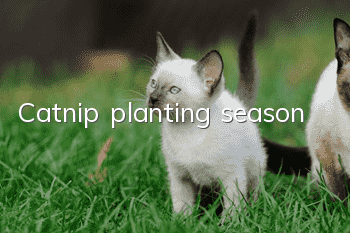Catnip planting season

Catnip planting season:
1. The best catnip planting season is spring and autumn; catnip likes a cool, full sun or half sun environment, generally in autumn. Live broadcast and transplant in summer; in the south, direct seeding can be done in spring and autumn. Care must be taken during the period to prevent root fungal infection.
2. Catnip prefers a cool, full-sun or half-sun environment. It is generally sown in autumn and transplanted in summer. In the south, it can be sown in spring and autumn. The best flowering period is the early flowering period. You should choose a place with sufficient sunshine and good ventilation.
Methods for growing catnip:
1. Soil. To grow catnip, you need to choose soil with good drainage. You can use horticulture and humus. In addition, the size of the flower pot should be suitable. Do not choose a flower pot that is too small, otherwise it will affect the growth of the catnip root system.
2. Sowing. You can plant seeds directly by purchasing them. It is very convenient. It is recommended to sow in spring. The most suitable temperature is 18 to 22℃. Place drainage stones at the bottom of the flower pot, pour soil over it, and sow seeds directly. Plant 1-3 seeds in each hole. Cover with soil about 1 cm and flatten it. Water appropriately. After sowing, place it in a cool place. Do not place it directly. It will take 7-10 days to germinate under the sun. After sowing and emergence, fertilize 1-2 times a week. After the small buds grow, you need to increase the lighting time. If there is insufficient sunshine, it will easily affect its growth and flowering.
3. Care. Catnip likes to grow in a relatively humid environment. In summer, it needs to be watered basically every day. At the same time, it is very afraid of waterlogging, so the amount of water must be controlled well. Wait until Water the pot again after it is dry. In winter, when temperatures are low, water as little as possible. It does not require a lot of fertilizer. Generally speaking, you can use some diluted liquid fertilizer every week. A certain amount of light needs to be ensured every day.
4. Sterilization. Generally, catnip is not affected by diseases and insect pests, but has an anti-mosquito effect. It only needs to prevent root fungal infection, and pay attention to avoid soil with a lot of clay content. Poor drainage will lead to fungal reproduction and harm plants. Healthy growth. You can spray a special fungicide for flowers once to effectively prevent fungal root rot. In daily maintenance, pay attention to waiting for the soil to be completely dry before watering.
5. Pruning. Catnip has a very strong growth ability, so when breeding it, you should pay attention to trimming it frequently. The more trimming, the more it can promote its growth. Cutting off some long branches can concentrate nutrients for reproductive growth and encourage it to bloom beautiful flowers. In addition, because it has a special smell, generally speaking, as long as you pay attention to the cleanliness of the pot, it will basically not be infected with pests and diseases. However, after transplantation, the plants should be watered with fungicides to reduce the infestation rate of diseases and insect pests.
- What effect does Moutian Polygonum have on cats? Is it harmful to cats?
- The quickest solution to a bloated cat’s belly
- Why doesn’t the cat’s fur grow even after being shaved for half a year?
- Why does the cat meow at the door?
- Is it normal for a cat to sleep all the time? Is it normal for a cat to be sleeping all the time?
- How to tell the difference between male and female newborn kittens
- How to avoid cat loss, four tips to reduce the risk of cat loss!
- How to train a cat to stand up and receive food? Tips for training cats!
- What should I do if my cat becomes hoarse?
- If you take your cat out for a walk, will the cat know the way home?



